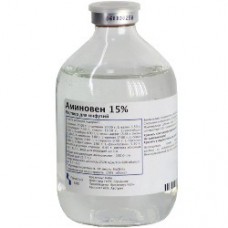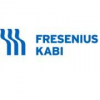Expiration date: 11/2026
Release form
Solution for infusion
Composition
In 1 liter of solution for infusion contains: L-isoleucine 5.2 g, L-leucine 8.9 g L-lysine acetate 15.66 g (corresponds to the content of L-lysine 11.1 g), L-methionine 3.8 g, L-phenylalanine 5.5 g, L-threonine 8.6 g, L-tryptophan 1.6 g L-valine 5.5 g, L-arginine 20 g, L-histidine 7.3 g L-alanine 25 g, 18.5 g glycine, L-Proline, 17 g, L-serine 9.6 g, L-tyrosine 400 mg, taurine 2 g
Auxiliary substances: glacial acetic acid 4.45 g, malic acid (to maintain pH) and 4.9 - 6.1 g, water d/and up to 1 L.
Packaging
Pack of 10 vials for 500 ml.
Pharmacological action
Aminoven 15% intended for parenteral nutrition of patients with various pathologies with low, normal or increased protein needs when enteral nutrition is ineffective or impossible. Contained in Aminoven essential and nonessential L-amino acids are natural physiological compounds. As amino acids coming from food and produced by the breakdown of proteins, parenteral amino acids are introduced into a common pool of free amino acids of blood plasma and into cells for protein synthesis and various metabolic pathways.
Testimony
- Total or partial parenteral nutrition. The amino acid solutions are usually used in combination with a sufficient quantity of energy sources (glucose, fat emulsions).
- Prevention and therapy of loss of protein when oral or enteral nutrition is impossible, insufficient or contraindicated.
Contraindications
- Violation of the metabolism of amino acids.
- Metabolic acidosis.
- Renal insufficiency in the absence of hemodialysis or hemofiltration.
- Severe hepatic insufficiency.
- Fluid overload.
- Shock.
- Hypoxia.
- Decompensated congestive heart failure.
- Newborns infants and children under 2 years of age: should use the adapted children's products of amino acids, the composition of which is specially designed to meet the metabolic needs of children (infant Aminoven).
- It is not recommended to appoint Aminoven 15% in children (under 18) due to lack of adequate clinical experience in this age group.
Application of pregnancy and breastfeeding
Special studies of the safety of Aminoven during pregnancy and lactation have not been conducted. However, clinical experiences with similar parenteral amino acid solutions indicates the absence of risk to pregnant and lactating women. Before the introduction of Aminoven pregnant or lactating women should evaluate the ratio of "risk-benefit".
Method of application and doses
Aminoven of 15% should be administered only in a Central vein. Infusion can be continued as much time as required by the clinical condition of the patient, on the basis of daily requirement of amino acids.
Adults
Average daily dose: 6.7-13.3 ml Aminoven 15% per kg body weight (equivalent to 1.0-2.0 g amino acids per kg of body weight), which corresponds to 470-930 ml Aminoven 5% for a patient weighing 70 kg.
Maximum daily dose: 13.3 ml Aminoven 15% per kg body weight (equivalent to 2.0 g amino acids per kg of body weight), which corresponds to 930 ml Aminoven 15% for a patient weighing 70 kg.
Maximum infusion rate: 0.67 ml Aminoven 15% per kg of body weight per hour (equivalent to 0.1 g amino acids per kg of body weight/h).
Children: not recommended Aminoven 15 % have children (under 18 years). Newborn infants and children up to 2 years: use adapted children's products of amino acids, the composition of which is specially designed to meet the metabolic needs of children (infant Aminoven).
Special instructions
It is recommended to use Aminoven 15% have children (under 18 years). Should monitor the level of electrolytes, fluid balance and renal function. In the case of hypokalemia and/or hyponatremia should simultaneously introduce sufficient quantities of potassium and/or sodium. The introduction of any amino acid solutions can cause acute folate deficiency, therefore, patients should daily introduce folic acid. Care should be taken during infusion of large fluid volumes patients with heart failure. Any infusion into a peripheral vein may cause irritation to the vessel wall and thrombosis. Therefore, it is recommended every day to inspect the place of installation of the catheter. If the patient is also assigned the introduction of the fat emulsion, it should introduce possible simultaneously with Aminophenol to reduce the risk of phlebitis. The choice of the location of catheter (Central or peripheral vein) is determined by the final osmolarity of the mixture for infusion into a peripheral vein, the limit of osmolarity is 800-900 mOsm/L. in addition, you should take into account the age, clinical condition of the patient and his condition of peripheral veins. Should strictly observe the rules of asepsis, especially when installing a catheter in a Central vein. Use immediately after opening the bottle. For single use only. The entire unused balance of the solution in the vial and the whole mixture remaining after infusion must be destroyed. Use only clear, particulate free solution from an intact container.
Special conditions of storage after mixing with other components: Aminoven can be mixed under sterile conditions with other drugs for parenteral nutrition, such as fat emulsions, carbohydrates and electrolytes. Mixtures for parenteral nutrition should be used immediately. In exceptional cases it is possible to store the mixture for not more than 24 hours at +2 - +8°C.
In hepatic and/or renal insufficiency require individual dosage.
Drug interactions
Currently, the cases of interaction is unknown. Due to the increased risk of microbiological contamination and incompatibilities, amino acid solutions should not be mixed with other medicinal products that are not intended for parenteral nutrition. Aminoven can be mixed with Dipeptiven, strictly observing the rules of asepsis. You should not add a mixture of other drugs.
Overdose
Symptoms: in overdose Aminoven or exceeds its rate of infusion may be observed: chills, vomiting, nausea, increase the excretion of amino acids through the kidneys.
Too rapid infusion can overload the patient with fluid and electrolyte disturbance.
Treatment: in case of signs of overdose, the infusion should be discontinued immediately. In the future, it may resume at reduced dosage.
A specific antidote in case of overdose does not exist. Emergency arrangements should be General supportive, with particular attention to the function of the respiratory and cardiovascular systems. The importance of the control of biochemical parameters and appropriate treatment of violations.
Storage conditions
Keep at temperature not above +25ºC. Do not freeze.
Shelf life
2 years.


